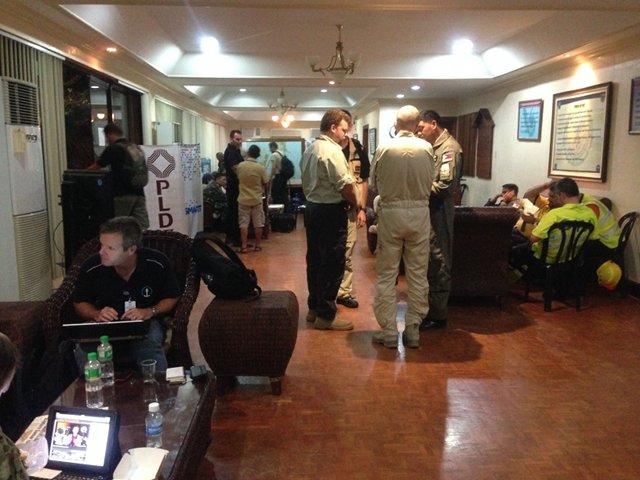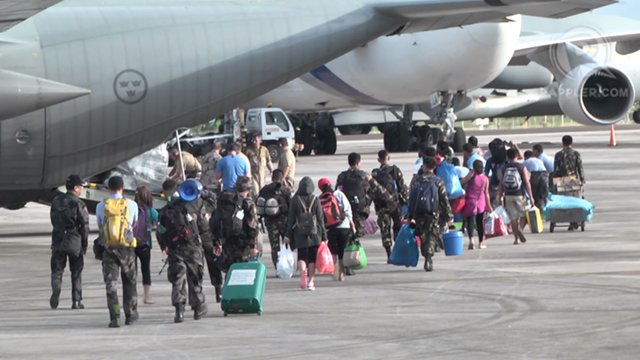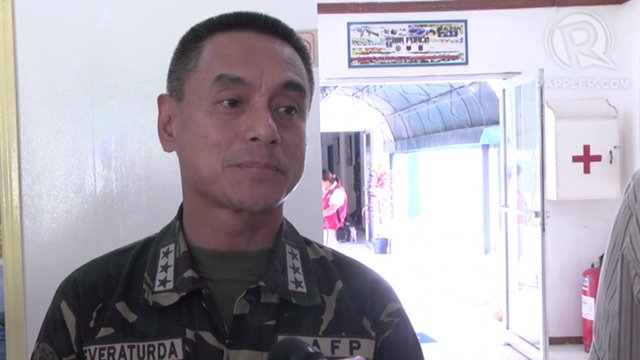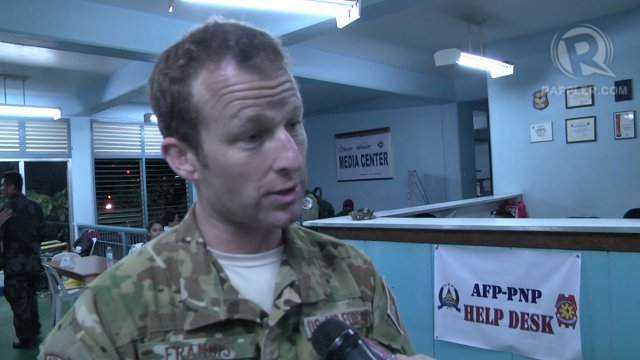
THE COALITION.' The relief operations for Super Typhoon Yolanda (Haiyan) is the work of several militaries, NGOs and international groups led by the Philippine government. This is the base of their operations at the Mactan Airbase. Photo by Ayee Macaraig/Rappler
CEBU, Philippines – The base operations at the Benito Ebuen Air Base in Mactan for relief efforts for Super Typhoon Yolanda (Haiyan) is a virtual United Nations.
On the tarmac, an Australian Air Force plane takes off while an Emirates aircraft lands. Outside the gate, an American soldier counts the heads of the responders and Filipino relatives boarding a flight to Tacloban. In the VIP room, ambassadors get updates on the relief work. Right outside, Japanese medics huddle while Spanish relief workers conduct their own informal briefing.
The languages are different, the groups countless. Yet there is only one goal: to get the people and cargo moving so the victims of the world’s strongest typhoon have much-needed food, water, shelter and medical care.
Soldiers, diplomats and aid workers at the command base give Rappler a look into what they call one of the most massive and complex relief operations they have seen.

TACLOBAN-BOUND. Relief workers, soldiers and families of relatives board a flight at the Mactan Airbase bound for Tacloban. Photo by Franz Lopez/Rappler
Philippine-led ‘coalition’
A province west of Samar and Leyte in central
The Philippine military directs the delivery of aid, with Lt Gen Roy Deveraturda, chief of the central command of the Armed Forces of the Philippines (AFP) leading what soldiers often refer to as the “coalition” effort.
“There’s a lot of pieces in the puzzle. Overall you have
Deveraturda said the Philippine Air Force (PAF) in the Visayas flies more than 12 flights every day, delivering aid and transporting refugees. This excludes flights from
The countries also divide the work geographically. Major Jimmy Francis of the US Air Force said the
“The USS George Washington is there with a fleet of SH-60 helicopters and they’re covering the east coast. Also, the US Marine Corps was bringing in supplies to Guiuan. I don’t think they’re quite going to Borongan yet but in the future, in the next couple of days, they’re gonna start doing that, also Ormoc and of course, Tacloban,” Francis told Rappler.
They also divide the work according to time.
Francis said, “There are some

TEAM COMMANDER. Lt Gen Roy Deveraturda of the Armed Forces of the Philippines Central Command leads the Haiyan relief efforts for the Visayas at the Mactan Airbase. Photo by Franz Lopez/Rappler
Problem of airfields, land transport
Officials admit logistics is a key challenge, particularly how to transport aid.
“It’s on a certain level of
Gilbert said the whole group is using a lot of equipment to address the problem.
“It entails everything from big things like planes to things you wouldn’t necessarily think about like forklifts, trolleys to move supplies. I think the biggest challenge for logistics is airfields in some regard. We can only bring heavy planes into certain areas. We can’t fly heavy planes into small villages. That’s where the arrival of the
Francis said the
Having worked in recovery in the 2010
“The breadth of destruction is pretty wide. Transportation is very difficult on the ground. There are many barangays that are unreachable. There are a lot of aviation assets so I think we are getting to all those locations slowly but surely.”
Beyond logistics, coordination is also a challenge.
“You have different agencies with their own languages of operating: governments, militaries, civilians. It’s extremely difficult. Oftentimes, there’s not one authority that directs everything. It’s kind of a joint cooperation so as long as there’s communication between everybody, we have a good way forward,” Francis said.

COMPLEX WORK. Major Jimmy Francis of the US Air Force says the Haiyan relief operations is one of the most complex he has been part of. Photo by Franz Lopez/Rappler
Catching up with aid delivery
Lt Jim Alagao, spokesperson of the AFP Central Command, said that 9 days after the typhoon, the relief effort is still in the early stage, focused on feeding the victims.
Alagao said though that there has been improvement in the delivery of aid.
“I talked to some foreign reporters who went to Guiuan on Friday and their observation was there were no trucks, only motorcycles. When they came back Saturday, they were surprised there were 30 to 40. That came from
Francis said the priorities in the coming days will be to shift from providing the basic needs to infrastructure like water purification systems and tent cities. The
Indonesian Ambassador Kristiarto Legowo said his country brought in a C130 on Saturday and the Indonesian contingent will stay until November 24 to support the humanitarian operations, upon the request of the AFP. A new Japanese medical team also flew to Tacloban on Saturday.
The European Union’s Altheim said the EU is pledging 30 million euros to the recovery efforts.
The international team though acknowledged criticism about the pace of relief efforts.
“I know it’s a little bit slow and I’m sure it’s very frustrating for the people on the ground but I think the coalition is really starting to catch up with the aid,” Francis said.
For Gilbert, assessing the work involves taking into account the realities on the ground and the scale of the devastation.
“Here in the
“That’s a very hard problem to solve.”
http://www.rappler.com/nation/43907-inside-the-haiyan-international-relief-base

No comments:
Post a Comment
Note: Only a member of this blog may post a comment.